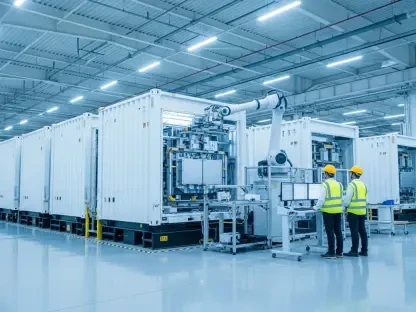The demand for artificial intelligence (AI) and digital services is on a steep rise, driving a significant transformation in the data center industry, which is characterized by substantial developments in infrastructure, technological advancements, and regulatory changes. These developments aim to support and sustain the substantial growth of data centers as they become critical components in the facilitation of AI and digital services.
Rapid Expansion and Transformation
The data center industry is undergoing an unprecedented expansion driven by the explosive growth of AI and digital services, leading to a transformative phase that focuses on upgrading existing infrastructure and incorporating advanced technologies to manage the growing demand. With the surge in digital services, data centers have become integral to supporting and enabling this growth, drawing substantial capital investments that have the potential to lead to market consolidation, signaling a shift in the industry landscape.
The transformative phase of data centers involves a comprehensive overhaul of their infrastructure to handle increased data loads and ensure efficiency. Enhancements are being made to physical infrastructure, including the implementation of advanced cooling systems and robust power management solutions to cope with the high energy demands of modern data centers. Additionally, the integration of cutting-edge technologies such as AI-powered management systems and virtualization enhances the operational efficiency and scalability of data centers, making them better equipped to meet the increasing digital service needs.
Federal Support and Legal Initiatives
Federal initiatives have been pivotal in supporting the growth and development of data centers in the U.S. Both the Biden and Trump administrations have underscored the importance of fostering a conducive environment for the data center industry through executive orders and regulatory adjustments. President Biden’s executive order places significant emphasis on addressing the energy needs of data centers by promoting geothermal projects and designating land sites specifically for AI data centers. This approach aims to ensure that data centers have access to sustainable energy sources and suitable locations to support their expansion.
In contrast, President Trump’s executive order focused on creating a regulatory environment that supports U.S. global AI dominance, targeting regulatory barriers that could impede the growth of data centers. The Federal Energy Regulatory Commission (FERC) has also played a critical role by initiating reviews of co-location regulations to maintain grid reliability and ensure fair consumer costs. These federal efforts highlight the government’s commitment to bolstering the data center market, providing the necessary legal and regulatory framework to support its growth.
Changing Energy Market Dynamics
As data centers become major consumers of electricity, their growing energy demands are significantly reshaping the dynamics of energy markets. Data centers in the U.S. are projected to account for a substantial share of total power demand, necessitating strategic planning and investment to ensure grid reliability and fair consumer costs. This increased energy consumption underscores the importance of diverse energy market players, notably hyperscalers and bitcoin mining operations, each contributing uniquely to the energy demand landscape.
Hyperscalers, which are large-scale cloud service providers, prioritize energy efficiency and sustainability by investing in renewable energy sources and advanced cooling technologies. Their focus on sustainability not only reduces their environmental impact but also helps manage operational costs by lowering energy consumption. On the other hand, bitcoin mining operations, known for their high energy usage, adjust their processes based on energy market signals to optimize their computational efficiency. This adaptive approach impacts grid planning by requiring flexible and scalable energy solutions to accommodate the fluctuating demands of large-scale mining operations.
Technological Innovations for Sustainability
To address the energy-intensive nature of data centers, technological innovations are being developed and adopted to enhance sustainability. One such strategy involves co-locating data centers with generation assets, enabling them to utilize existing energy infrastructure efficiently. Another approach focuses on developing onsite renewable energy generation, such as solar and wind power, to reduce reliance on traditional energy sources and lower carbon footprints. These strategies are pivotal in promoting sustainability within the data center industry.
Advanced cooling technologies play a crucial role in managing the extensive cooling requirements of data centers, which are essential for maintaining optimal operating conditions and preventing overheating. Solutions such as liquid cooling and immersion cooling are gaining traction due to their efficiency in dissipating heat and reducing energy consumption. Additionally, innovative approaches like chilled water refrigeration and heat reusability are being explored to further enhance cooling efficiency and sustainability. The adoption of these advanced cooling technologies not only mitigates the environmental impact of data centers but also supports their long-term operational viability.
Commercial and Legal Challenges
The rapid expansion of data centers brings several commercial and legal challenges that operators and utility companies must navigate. Rising electricity costs are a significant concern, necessitating long-term contracts to ensure price stability and manage operational expenses. Utility companies, wary of the risk of stranded infrastructure, often demand up-front payments for new generation and transmission infrastructure projects, which can strain the financial resources of data center operators.
Another major challenge lies in the complex interconnection processes required to connect new data centers to the power grid, particularly in power-constrained areas. This process can be lengthy and cumbersome, sometimes taking years to complete due to significant permitting and regulatory requirements. Effective planning, coordination, and collaboration among tech companies, utilities, and regulators are essential to streamline these processes and ensure timely integration of new data centers into the grid.
Increase in Deal Activity
The surge in demand for artificial intelligence (AI) and digital services is prompting a significant transformation in the data center industry. This shift is marked by noteworthy advancements in infrastructure, technological innovations, and revised regulatory frameworks. As AI and digital services grow more critical, data centers are evolving to meet these heightened requirements.
Infrastructure improvements are crucial to accommodate the vast amounts of data generated by AI applications and digital services. Technological advancements, such as more efficient cooling systems, high-speed processors, and increased storage capacity, are becoming essential. Additionally, regulatory changes are being implemented to ensure the sustainability and security of these burgeoning data centers.
The exponential growth of AI and digital services underscores the importance of modern, efficient data centers. These facilities are no longer just storage spaces but pivotal hubs for data processing and analysis. As they continue to evolve, data centers will play an increasingly vital role in supporting the advanced technological ecosystem necessary for AI and digital services. The continuous progression in this industry reflects its critical function in our increasingly digital world.









